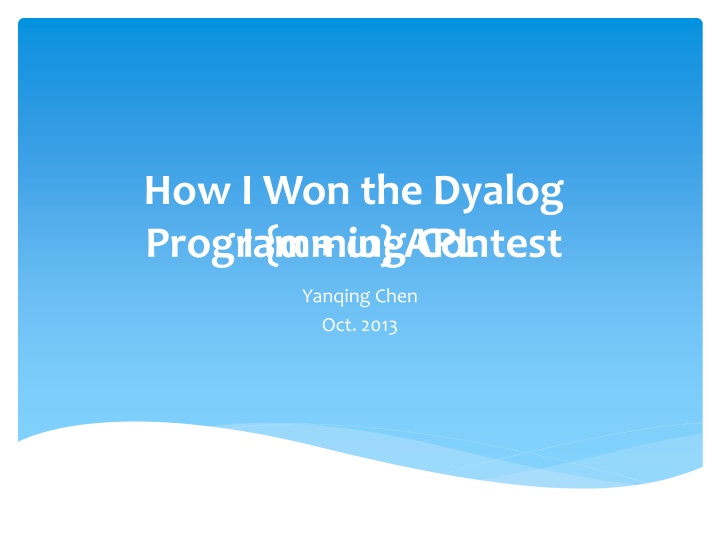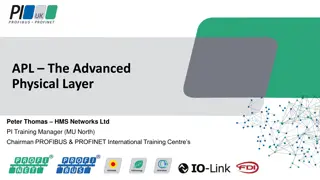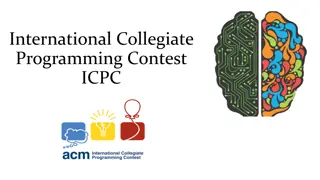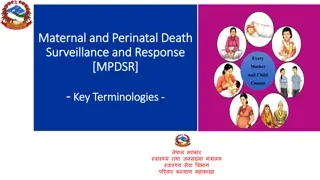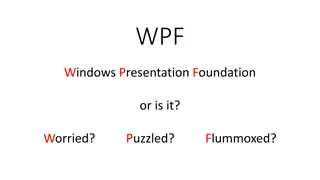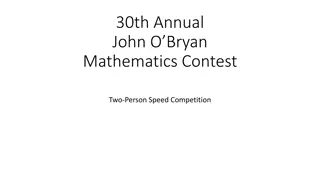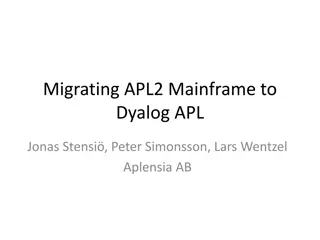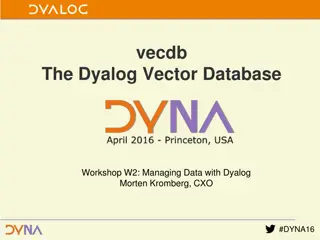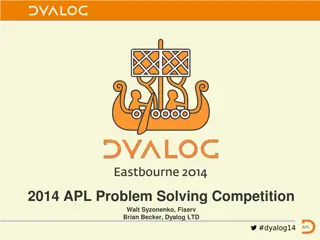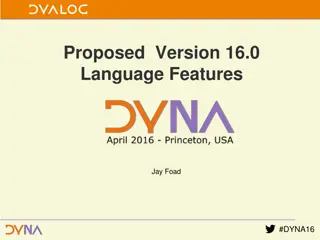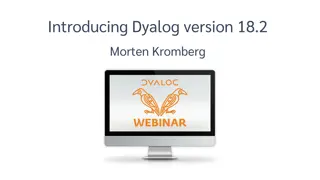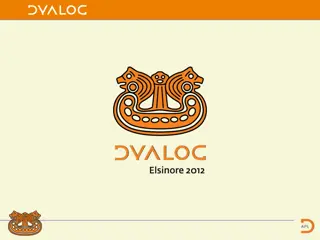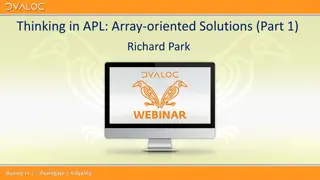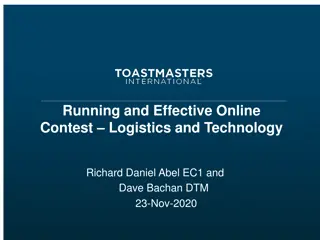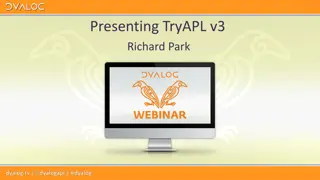Winning the Dyalog APL Programming Contest - Yanqing Chen
Yanqing Chen, a PhD student at Stony Brook University, shares his journey of winning the Dyalog APL Programming Contest in October 2013. He delves into his exposure to APL programming, learning experiences, the power of scripts, array-oriented thinking, and challenges with polyominoes. His insights highlight the unique approach APL programmers take, starting with pre-arranged symbols, avoiding unnecessary loops, and focusing on clean code. The narrative also touches on the transformational role of tutorials, like "Mastering Dyalog APL" by Bernard Legrand, in shaping his APL skills. Yanqing shares snippets of code and visual representations to illustrate key concepts, emphasizing simplicity and efficiency in programming. His story encapsulates the essence of APL programming and the intricate art of problem-solving in the contest.
Download Presentation

Please find below an Image/Link to download the presentation.
The content on the website is provided AS IS for your information and personal use only. It may not be sold, licensed, or shared on other websites without obtaining consent from the author.If you encounter any issues during the download, it is possible that the publisher has removed the file from their server.
You are allowed to download the files provided on this website for personal or commercial use, subject to the condition that they are used lawfully. All files are the property of their respective owners.
The content on the website is provided AS IS for your information and personal use only. It may not be sold, licensed, or shared on other websites without obtaining consent from the author.
E N D
Presentation Transcript
How I Won the Dyalog I { + } APL Programming Contest Yanqing Chen Oct. 2013
About me I am a PhD student at Stony Brook University, New York. I come from Shanghai, China. I like playing musical instruments. I major in Computer Science. I do research in the field of Natural Language Processing with Professor Steven Skiena. I title myself as an algorithm person.
How I get in touch with APL Back to the year of 2009, I happened to expose -- very very little part of myself to APL programming. res 0 :If 0< Y :For X :In Y res res + Y [X] :EndFor res res Y :EndIf
More APL In the year of 2011, my friend introduced me to Dyalog programming contest. Fortunately, this time I found a powerful tutorial Mastering Dyalog APL by Bernard Legrand This book successfully tweak my thought of APL and help me learn APL from the scratch.
Powerful Script! Strange symbols in APL represent different script! While other people construct their castle from regular bricks, APL programmers actually start from a pile that already being arranged for different uses. Programming is easier and the code is even shorter.
Array-oriented thinking The other important part in APL. Make the operators work on vectors of input! Avoid unnecessary loop expressions. Clean code and neat logic.
Polyominoes Given two polyominoes, check if one is some combinations of rotation and/or reflection of the other. Tell if a 0-1 matrix represents a valid polyominoes. Generate all distinct valid N-ominoes.
Rotate? Reflect? The core part might be getting all possible polyominoes q which can be obtained from original polyomino p given operations of flip and rotate q (( [1]2 2 2 -1- 8)/ ( ' ')), ( 'p') One line of 42 characters!
Regularize Among these possible results, I need a regularized shape so that only similar polyominoes share same regularized shape. Pick the one with largest encoding value from q: q[ {2 , } q] Still one line!
Almost done! Now I have a regularized form for any polyomino p! Of course there are some other steps to finish this function: p ( p)/( / p) p --Remove blank lines/columns, before rotating q ({ [2] } q)/q --Reform and check shapes, after rotating
ValidPoly If a matrix p contains only one 4-connected part, then it is valid. I need a function, FindConnectedParts, to label all connected parts in a 0-1 matrix p. After that the valid judgment can be written as: 3> ,FindConnectedParts p
FindConnectedParts First I give all non-empty cells in p with a different label. Then the idea is to apply Breath-First-Search enough times. (BFSOneStep (+/+/p))(p>0) ( p) ,p
BFSOneStep I try to shift the label in 4 different directions: (p>0) p ((1 p) 0) (0 1 p) (1 [2]p,0) (0, 1 [2]p) And keep those which labeled 0 unchanged. We are all set with the help of these two 1-line- functions!
Generate N-0minoes This is kinda recursive remind me of Mathematical Induction A valid N-omino can be constructed by adding 1 unit block to a (N-1)-omino, and there is a initial status N=0 So here is my logic: r ({ ,/AddOneBlock } n)( 0 0 0)
AddOneBlock p 0 (0,p,0) 0 tmp ( p) [1 2](( p) ,p) .= ,p tmp ((1++/+/p)=+/ +/ tmp)/tmp r ,Regularize ( ValidPoly tmp)/tmp Slightly longer? But it is still in 4 lines of code!
Math/CS section cleared! Awesome script functions! Combination of single character script can finish 80% of the job
Dimension I consider this to be a very important experience in programming APL. Display function For each operator ( ), nested array.
Is that enough? I am a CS student and I finished CS section, but Nothing can stop me from peeking what is inside Engineering section. Plus, I m really getting addicted to APL let s go to the Duck test!
The Duck Test Given an 0-1 matrix, find the center of gravity using a specific coordinate. Help robot locate object on the ground! A real test! Recognize and locate all ducks!
Find center of gravity A simple simulation. Calculations on X-axis and Y-axis are independent. This is the coordinates in Screen coordinates. (n m) p ((+/(-((m+1) 2)- m) + p)(+/(((n+1) 2)- n) +/p)) (+/+/p)
Optical Illustration 3-d coordinates (x, y, z) Camera: (0, 0, 10) Center of screen: (0, 5, 10) Screen: (-5, 5, 6) (-5, 5, 14), (5, 5 6), (5, 5, 14) A point (??,??) in screen coordinates will be (??, 5,10 + ??) in 3-d coordinates The projection point on the ground (??,??) follows: ?? 0 ?? 0 and (10+??) 10 ?? 0 5 0= =0 10 ?? 0 5 0
Locate Thus the true point on the ground for a given screen system point (x y) is, by optical transformation: (x 10 y)( 50 y) While the point (x y) on the screen we need to find is: (x y) ((FindCG img)+0, MinMax img) (8 5) img
MinMax This function is used to find the top most coordinates and the bottommost coordinates. tmp ( /img)/((1+ img) 2)- img List of Y values having observed points Return top/bottom values as: ( /tmp)( /tmp)
Ducks and balls What is the feature of ducks and balls? Both contain a connected parts of yellow pixels What is the difference between ducks and balls? Ducks have a connected parts of non-yellow pixels inside its yellow body
FindDucks q FindConnectedParts img=11 r FindConnectedParts img 11 s 1-{( <0)/ } ,{ -BFSOneStep }q (r>0) (r<8000) Consider only those non-yellow non-background enclosed connected parts as duck features (eyes)
FindDucks Locate ducks projection points q [2 3]s .=q ans (( s),2) ,/Locate q Estimate height of ducks using the top and bottom observed points, applying optical transformation according to the geometry ans ans,(1.6 img) ans[;2] 1+{ ( 1 )-1 }MinMax q
Eng section Cleared This part of the contest is more practical. Not just solving an algorithm issue Feels like the program can be actually used in real situations http://cto.dyalog.com, Raspberry Pi Robot
Broadcasting & Overloading Restricted a lot on the flexibility of programming if NO broadcasting/overloading. --multiply a matrix with an integer without changing the type. --create vectors of similar dimensions together and apply array-oriented operations The programmer have to be familiar with the dimensions of the variables.
Predator and Prey simulation Simulate a 1-varible recursive function. Simulate a 2-varible recursive function and predict the trend. Simulate a matrix recursive function.
NextGen :Trap 0 r 0 N 1+B Neq-N :Case 11 r / :EndTrap If an DOMAIN ERROR occurs, return the maximum number
GenX 1 ({B Neq(NextGen )} A)B Neq N Apply NextGen for a certain number of generations
PredPrey (({ PredPreyNextGen,( 1) } (gen-1))1 6 Neq N R P S C)[;2 4] Apply PredPreyNextGen for a specific number of generations Accumulate results in the matrix Return two columns of N and P history
PredPreyNextGen r PredPreyNextGen(Neq N R P S C);Nnext;Pnext Nnext 0 (N 1+(R-1) 1-N Neq)-C N P Pnext 0 S N P Neq r Neq Nnext R Pnext S C According to the formula, calculate the next generation of predators and preys
OutcomeType There are 4 types of outcomes.
OutcomeType p p[1;] q (((2 p)<(1 1 p)) (1 1 p)>( 2 p))/(1 1 p) Pick all peak values of prey populations X +/(1 q)> 1 q Y +/(1 q)< 1 q Z +/(1 q)= 1 q
Bunnies and Foxes on an island N*N matrix where each cell is a dwelling place In each round: -- calculate the procreate rate for predators and preys in each dwelling place -- simulate the birth and death of an individual -- simulate the migration procedure that allow an individual to move to an adjacent cell.
Around r mat Around n;x1;x2;y1;y2 Calculate observed density around the n-th cell in mat within a 7 7 area (x1 y1) 1 2+( mat) n-1 (x2 y2) ( mat) 4+( mat) n-1 Indexes of max/min X/Y r (+/,mat[((x1-1)+ x2+1-x1);((y1-1)+ y2+1-y1)]) (x2+1-x1) (y2+1-y1) Calculate weighted average as observed density
Density r Density mat Calculate Observed Density of the matrix r ( mat) , ( mat)Around ,mat
Live r Live(m n) Given a procreate/die rate n in percentage, and individual number n Simulate the action of each individual and accumulate the number of next generation (m=0)/'r 0' ((n<0) (m>0))/'r m- +/ (-n) ?m\100' ((n 0) (m>0))/'r m n 100 n 100 n r r+ m++/ n ?m\100'
Procreate r Procreate(observe prob) Given observed count matrix and procreate/die probability matrix Simulate the populations of the next generation r ( observe) Live [1](,observe),[0.5](,prob)
Migrate r Migrate p;q;s r ( p) 0 q ( p) 5 q ( 1+1 q) (1 1 q) ( 1+ 1 q) q ( 1+1 [2]q),(1 [2] 1 [2]q),( 1+ 1 [2]q) 3 4 4 4 4 3 4 5 5 5 5 4 4 5 5 5 5 4 3 4 4 4 4 3
RandomPick r RandomPick(m n) Util simulating function m individual each have n evenly distributed choices Similate how many among them made the first choice r 0 (m>0)/'r +/1=?m\n'
Migrate s ( 1 p) RandomPick [1](,1 p),[0.5](,1 q) (r p q) (r p q)-((-s 0)(0 s)(0 s 0)) s ( 1 p) RandomPick [1](, 1 p),[0.5](, 1 q) (r p q) (r p q)-((-0 s)(s 0)((s 0) 0)) s ( 1 [2]p) RandomPick [1](,1 [2]p),[0.5](,1 [2]q) (r p q) (r p q)-((-s,0)(0,s)(0,s 0)) s ( 1 [2]p) RandomPick [1](, 1 [2]p),[0.5](, 1 [2]q) (r p q) (r p q)-((-0,s)(s,0)((s 0),0)) r r+p
PredPreyIsland r PredPreyIsland(island Neq R S C);o_prey;o_pred;len;tmp;p_prey;p_pred (0=(+/+/island[1;;]) +/+/island[2;;])/'r (island Neq R S C) 0' len ,island[1;;] (o_prey o_pred) Density [2 3]island tmp len 6 ,/PredPreyNextGen [1]6 len ,/((len\Neq)(,o_prey)(len\R)(,o_pred)(len\S)(len\C))
PredPreyIsland p_prey ( o_prey) 400 100 (tmp[;2]- ,o_prey) ,o_prey p_pred ( o_pred) 200 100 (tmp[;4]- ,o_pred) ,o_pred o_prey Migrate Procreate island[1;;]p_prey o_pred Migrate Procreate island[2;;]p_pred r (o_prey,[0.5]o_pred)Neq R S C Reform output format
BunnyFox r island BunnyFox(gen Neq R S C) r ((PredPreyIsland gen)island Neq R S C)
Bio section cleared! All simulations Lines of codes greatly distinguished from the other two sections Quite open as a real project from biologist If the description could be better
Nice experience! I enjoyed the contest! It s always good to have background varieties. Real problems in different fields are attractive.
Nice experience! APL code provide a direct way of showing your thought. I feel that there are still much to learn. I tried less than 70% of the content from Mastering Dyalog APL . APL can do much more than I thought before.
